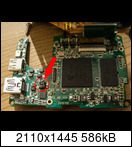Hello guys,
a few days ago a had a little problem with my Git 2. I connected the cam to an USB power adaptor, and after about one second there was a little pop sound and some smoke left the cam - a capacitor has exploded.

As you can see in the picture, the capacitor is on the back of the front PCB, right underneath the lense.
I don't know if it was caused by the cable or adaptor (both were not mine). But the cam does still work. The only thing is that the cam can not be run anymore by an external power supply. Charging the battery in the cam is also impossible now. The rest works still fine.
Does any of you accidentally know which type of capacitor this is? I would try to replace it. It could already be enough to have the code on the capacitor to identify the type.
a few days ago a had a little problem with my Git 2. I connected the cam to an USB power adaptor, and after about one second there was a little pop sound and some smoke left the cam - a capacitor has exploded.

As you can see in the picture, the capacitor is on the back of the front PCB, right underneath the lense.
I don't know if it was caused by the cable or adaptor (both were not mine). But the cam does still work. The only thing is that the cam can not be run anymore by an external power supply. Charging the battery in the cam is also impossible now. The rest works still fine.
Does any of you accidentally know which type of capacitor this is? I would try to replace it. It could already be enough to have the code on the capacitor to identify the type.
